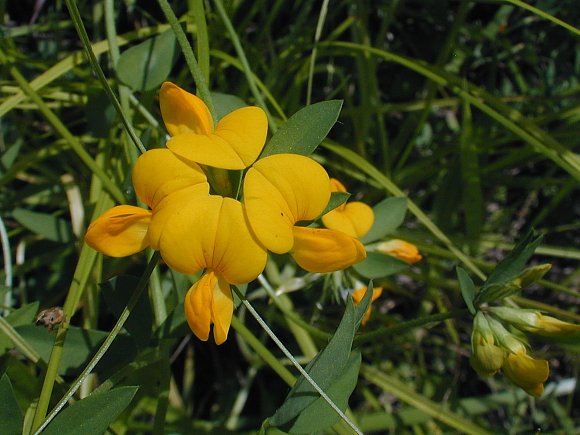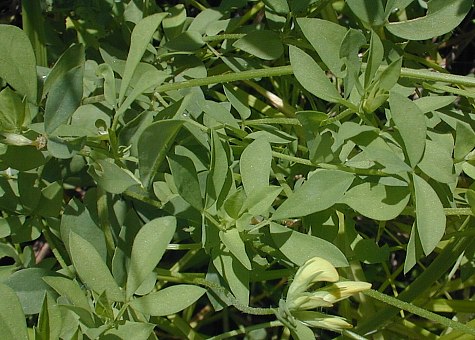Birdsfoot
Trefoil
Lotus corniculatus
Bean family (Fabaceae)
Description: This herbaceous perennial plant is ½–2' tall, branching occasionally. The round stems are slightly pubescent or hairless. The alternate compound leaves are trifoliate in appearance and have long petioles. However, there is an additional pair of leaflets where the petiole joins the stem. These leaflets are oblanceolate, lanceolate, or ovate, and rather angular. Their margins are smooth, and the veins are faint and irregular. Each leaflet is up to ¾" long and half as much across. In the upper part of the plant, umbels of 3–12 pea-like yellow flowers are produced on long stalks (peduncles). These flowers are about ½" long and have 5 petals, which are organized into a standard, wings, and a keel. The long teeth of the calyx are narrow and light green. In bright sunlight, the flowers may become tinted with orange-red. The blooming period occurs during early to mid-summer for 1-2 months. The flowers are replaced by linear seedpods that are up to 1" long and divide into two halves. The root system consists of a taproot. This plant reproduces by reseeding itself.

Cultivation:
Typical
growing conditions are full or partial sun, average levels of moisture,
and a loam or clay-loam soil. The root system probably adds nitrogen to
the soil by forming rhizobium-filled nodules. This plant can become an
aggressive pest.
Range & Habitat:
Birdsfoot Trefoil occurs primarily in northern and central Illinois
(see Distribution
Map), where it is locally common. This plant is probably more
common than official records indicate, as it is still spreading.
Birdsfoot Trefoil was probably introduced into the United States from
Europe. It has been used in the past to rejuvenate agricultural lands,
and to prevent soil erosion along banks near highways and ditches.
Habitats include fields, pastures, roadside embankments, slopes of
drainage ditches, weedy corners of parks, and miscellaneous waste
areas. The invasive potential of this weed appears to be above average
because it often forms dense colonies that tend to exclude other plants.
Faunal Associations:
Various long-tongued bees are the primary pollinators of the flowers.
Many kinds of insects undoubtedly feed on the foliage, including the
caterpillars of the butterfly Colias eurytheme
(Orange Sulfur). The foliage is mildly toxic to livestock and not
particularly high in protein for a member of the Bean family. Not much
is known about the faunal relationships of this exotic species, but the
Lotus spp. of the western United States have
foliage that is attractive to rabbits, deer, and other mammalian
herbivores. Their seeds are consumed by the Mourning Dove, Ring-Necked
Pheasant, and various small rodents.

Photographic
Location:
A woodland meadow at Judge Webber Park in Urbana, Illinois.
Comments:
The umbels of flowers of this plant have a crown-like appearance that
resembles Coronilla varia (Crown Vetch), except
that the latter species has purplish or whitish pink flowers. Another
distinctive characteristic of Birdsfoot Trefoil is the additional pair
of leaflets at the base of the petiole. Another member of this genus, Lotus
unifoliolatus (Prairie Trefoil), also occurs in Illinois, but
it is less common. This adventive western species has only 3 leaflets
per compound leaf and the flowers occur individually, rather than in
umbels. Birdsfoot Trefoil is quite attractive during the rather long
period of time in which it is in bloom.